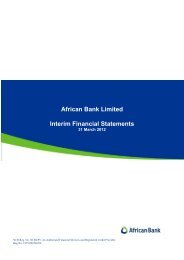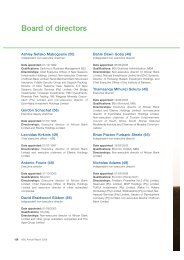Download - African Bank
Download - African Bank
Download - African Bank
Create successful ePaper yourself
Turn your PDF publications into a flip-book with our unique Google optimized e-Paper software.
Group risk function<br />
With the divisionalisation of the majority<br />
of the Theta subsidiaries into <strong>African</strong><br />
<strong>Bank</strong>, an opportunity to form a single<br />
group risk management function with<br />
responsibility for risk across all business<br />
units within the group has been created.<br />
Group Risk consists of the following<br />
departments:<br />
Internal audit and forensic<br />
Compliance<br />
Legal<br />
Company secretariat and<br />
corporate governance<br />
Operational risk and Basel II,<br />
Credit<br />
ALCO<br />
Its primary functions and responsibilities<br />
are:<br />
To develop and implement a groupwide<br />
risk policy and procedures that<br />
ensure that the group has a<br />
consistent and acceptable approach<br />
to the management and monitoring<br />
of risk across all business units;<br />
To manage centrally certain risk<br />
functions, ie compliance and<br />
operational risk , that either due to<br />
regulatory or cost efficiency reasons<br />
are not delegated to the business<br />
units;<br />
To act as a facilitator and overall coordinator<br />
of certain risk functions,<br />
eg credit, that are delegated to the<br />
business units for day-to-day<br />
management;<br />
To build and foster a good working<br />
relationship with the regulators to<br />
ensure constructive and open<br />
communication;<br />
To work proactively with Exco and<br />
the businesses/divisions to ensure<br />
that all key risks are identified and<br />
appropriate controls put in place<br />
to manage these risks. This is<br />
particularly important where new<br />
businesses, systems and products<br />
are being introduced.<br />
Risk appetite<br />
Returns higher than the risk-free interest<br />
rate can only be achieved through risk<br />
taking. Furthermore, by virtue of its<br />
nature, a bank is in the business of taking<br />
risk. It is therefore of utmost importance<br />
that a bank, which the public has<br />
entrusted with their funds, defines its<br />
optimal risk level and determines<br />
whether the organisation has the<br />
requisite risk culture, risk management<br />
skills and risk absorption capacity to<br />
support the business strategy.<br />
Defining risk appetite<br />
Risk appetite is defined as the level of<br />
risk that is acceptable for the group to<br />
bear and is dependent on the extent to<br />
which it seeks and tolerates risk as<br />
described by predetermined<br />
performance indicators, operational<br />
parameters and process controls.<br />
The risk absorption capacity is largely<br />
a function of the bank’s capital and<br />
reserves in relation to the business<br />
strategy, cost effective risk mitigation<br />
controls and effective risk transfer<br />
strategies. However, cognisance has to<br />
be taken of the fact that banks have to<br />
take account of reputational risk which<br />
could negatively affect their liquidity<br />
position to such an extent that, despite<br />
sufficient solvency, ie surplus capital, it<br />
could result in a situation that the bank<br />
cannot trade.<br />
Risk culture<br />
The risk culture of an organisation plays<br />
a pivotal role in effective risk<br />
High<br />
Risk<br />
Low<br />
Low<br />
Avoid Mitigate<br />
Transfer<br />
Competency<br />
management. A “Risk control culture”<br />
and “Risk acceptance culture” are at<br />
opposite ends of the risk control<br />
spectrum. A “Control culture” strives to<br />
minimise risk by maintaining an attitude<br />
of low tolerance of risk and viewing risks<br />
in general in a negative light.<br />
Alternatively, a “Risk acceptance culture”<br />
views risk as an inherent part of running<br />
a successful business, ie risks are not<br />
only mitigated but are also investigated<br />
for potential opportunities and therefore<br />
provide a direct linkage between risk<br />
management and maximising<br />
shareholder value. A tolerance zone is<br />
created which allows risk taking within<br />
certain parameters. This culture is<br />
dependent on open communication<br />
where problems or concerns are<br />
identified and reported at an early stage<br />
rather than being suppressed. Problems<br />
and losses are viewed as part of running<br />
the business as long as cost effective<br />
controls are established and maintained<br />
to mitigate risks to an acceptable level<br />
within the set parameters.<br />
The following matrix can be used to<br />
assist with decisions on the treatment<br />
of various risks:<br />
Accept<br />
59<br />
High<br />
<strong>African</strong> <strong>Bank</strong> Investments Limited







